|
|

Exchequer
CHRA Stallion owned by Wicked Pony Ranch |
The
Rangerbred horse
|
The
Rangerbred horse is registered with the COLORADO RANGER HORSE ASSOCIATION,
INC. —the oldest of the western horse breed registries still in existence
in the United States. To meet the requirements for registration with the
CRHA, a horse MUST SHOW A DIRECT DESCENT from one of the two foundation
stallions 'MAX #2' and/or 'PATCHES #1'.
The
CRHA is NOT A COLOR REGISTRY. The founder wisely decided that a horse's
ability has nothing to do with his hide. Because of this, Rangerbreds
come in a wide variety of color patterns: from solid bays, classic blacks,
grays and roans all the way to colorful blankets and vivid tri-colored
leopards. The Rangerbred may be outcrossed on horses of other recognized
breed registries including, Jockey Club, Quarter Horse, Appaloosa (USA,
Canadian & Foreign), The Arab Horse Club, ARA-APP and the ICAA (with
certain reservations). The outcrossed mare must be registered with one
of the above registries or show positive proof of parentage tracing to
one of the registries accepted or a combination of the above registries
(with approval). There is a hardship clause for geldings and spayed mares
only.
In
1878, during a World Tour, General Ulysses S. Grant developed a friendship
with the Sultan Hamid of Turkey. Before leaving Turkey, the Sultan
presented Grant with two horses whose descendants continue to make an
impact on the horses of the World today. One was a desert Arabian named
LEOPARD and the other a Barb named LINDEN TREE. Both of these stallions
are listed in studbooks of two American breed registries, The Arabian
Horse Club and the Jockey Club. Their impact on the horse world touches
almost every breed in the United States today.
|
These
stallions arrived in 1879 in Virginia, where they spent several
years with Rudolf Huntington perfecting what Mr. Huntington hoped
would become a new breed of light harness horse. The introduction
of the "horseless carriage" contributed to the demise of that project.
Near the turn of the century, LEOPARD and LINDEN TREE moved west
to the ranch holdings of General George Colby in Beatrice, Nebraska.
Here the two desert stallions left an indelible impression on the
foals of the native mares on the Colby holdings. A new type of versatile
horse resulted whose reputation as GOOD USING HORSES "WITH A LOT
OF COW" soon spread.
|

Leopard
|
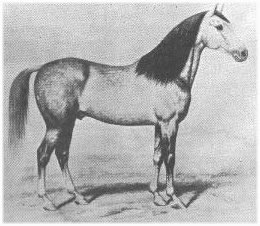
Linden
Tree |
The
Ira J. Whipple family introduced these horses to Colorado through
a group of mares and stallions purchased from General Colby. The
stallion was a double-bred grandson of LEOPARD, and the mares all
sired by either LEOPARD or LINDEN TREE.
Early in the 1900's, Mike Ruby, one of the greatest horsemen the
plains ever knew, developed an interest in these lines for their
reputation of working ability, good disposition, and stamina.
|
|
He
acquired PATCHES, a son of the stallion from the Colby Ranch, and
MAX, a halo-spotted son of the Waldron Leopard out of an Arabian
mare, as his herd sires. Mr. Ruby was different in many ways
than many of the ranchers of his day.. Well before most of the prominent
registries were founded, he maintained accurate written records
of his mares, stallions and their offspring. At this time these
records including foaling dates, colors and their complete pedigrees
was indeed an 'unusual' practice. These handwritten records have
been preserved as a part of CRHA Corporate records.
|
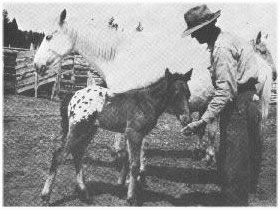
Mike
Ruby |
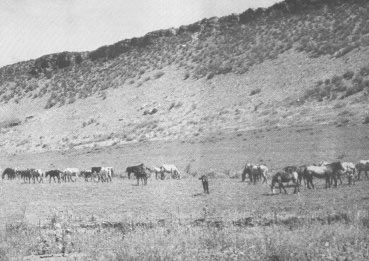
(1965)
From Lorne & Vera Knisley's Ranch - Southwest of Fort Collins, Colorado
near Horseshoe Mountain.
In
1934, Mr. Ruby was invited to display two of his stallions at the DENVER
STOCK SHOW. The two leopard patterned stallions (LEOPARD #3 AND FOX #10)
were seen by thousands of visitors. Encouraged by the faculty members
of what is now COLORADO STATE UNIVERSITY, the new breed of horse was officially
named COLORADO RANGERS, horses originating in Colorado bred and raised
under range conditions. Verbal references to those "range bred" horses
eventually led to their being more commonly known as Rangerbreds, although
the official name remains.
With the naming of the breed came a breed registry. Mike Ruby founded
the Colorado Ranger Horse Association in 1935. Two years later he applied
to the State of Colorado for corporate charter which was granted on January
4th, 1938. Due to registration only being available to CRHA members and
a fifty member limit imposed, many horses with Rangerbred heritage were
not able to be registered with the CRHA at that time. Those horses with
color patterns, however, were gladly accepted by another breed registry
that came into being several months later, The Appaloosa Horse Club.
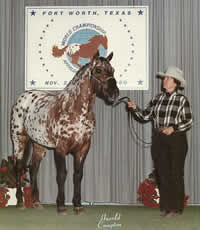 Dun Roven
Chelsea
Dun Roven
Chelsea
CHRA Stallion owned by Tanglewood Farm |
The
drought years in the mid-30's drove the aging horseman from the
Plains. Grass and water were gone. Refusing to see a lifetime's
endeavor destroyed, Mike made a trail herd and drove the J Bar Horses
from the eastern Colorado the new leases on the Western slopes of
the Rockies, a distance of over three hundred miles. He made horse
history on that drive. This man who could face adversity without
flinching, but who also had tears in his eyes as he told of a drought
mare who had been on the drive and whose newborn foal had died due
to lack of mother's milk. Four months later, in the lush mountain
meadows, the mare began giving milk for her colt that lay dead three
hundred miles back on the prairies. Two years later, the rains began,
he made another long drive back to home range.
|
In
1964, The Colorado Ranger Horse Association lifted the fifty member limit
and registration was opened up to all horses meeting pedigree requirements,
regardless of owner membership status. Since then, the CRHA has registered
many of the Appaloosas with Rangerbred heritage that were "lost" to the
organization for so many years. Additional Appaloosa bloodlines with Rangerbred
connections are still being recognized through continued pedigree research.
Most
recent research indicates that one out of every eight Appaloosas is eligible
for CRHA registry. Appaloosa pedigrees are checked for Rangerbred
heritage by the organization at no charge to the horse owner.
Myth
& Fact
A
special Thanks to Paula Mayes, Zone D Director, for this little bit of
factual information.
| MYTH: |
Rangerbred
horses are a cross between Appaloosas and Paints or Pintos |
| FACT: |
The
CRHA (Registry for Rangerbred Horses) is a bloodline registry. As
with the ApHC there are some approved outcrosses. PAINTS & PINTOS
ARE NOT AMONG THESE APPROVED OUTCROSSES. |
| |
|
| MYTH: |
Rangerbreds
are always small in stature |
| FACT: |
Like
most popular breeds, Rangerbred sizes range from 14.2 to 16+ hands
|
| |
|
| MYTH: |
Rangerbreds
must have Appaloosa Color and Characteristics |
| FACT: |
Although
many Rangerbreds do exhibit the color patterns associated with Appaloosas,
again, the CRHA is a Bloodline Registry. COLOR AND MARKINGS ARE
NOT CONSIDERED FOR REGISTRATION ELIGIBILITY, ONLY ANCESTRY. All
Registered Rangerbreds carry equal registration status regardless
of color. |
| |
|
| MYTH: |
The
COLORADO RANGER HORSE ASSOCIATION was formed to compete with the
Appaloosa Horse Club, Inc. |
| FACT: |
The
CRHA is an older registry than the ApHC. About 90% of all registered
Rangerbreds are also registered with the ApHC. |
| |
|
| MYTH: |
The
Colorado Ranger Horse Association promotes only "foundation" Appaloosa
Breeding |
| FACT: |
The
CRHA recognizes the same outcrosses as the ApHC and offers its members
the same choices as to preferred horse type. |
| |
|
| MYTH: |
There
are no benefits to CRHA Registry and Membership |
| FACT: |
The
CRHA tries to offer something for everyone, no matter what your
interest in horses. There is an ANNUAL NATIONAL SHOW,
FUTURITIES,
DISTANCE & ENDURANCE PROGRAM, LOGGING PROGRAM, OPEN SHOW PROGRAM
AND YOUTH PROGRAM and LIFETIME RECOGNITION AWARDS. There are
REGIONAL
CLUBS that offer their own activities of interest to their members
such as trail riding, driving clinics, picnics, sponsoring of local
shows & events, etc. |
| |
|
| MYTH: |
Very
few Appaloosas are Rangerbred |
| FACT: |
At
this time, it is estimated that ONE IN EVERY EIGHT APPALOOSAS IS
OF RANGERBRED HERITAGE. |
|
|
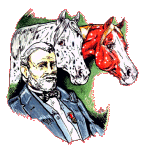 |
This
article was kindly provided by the Colorado Ranger Horse Association,
Inc
All Contents Copyright © 2000-2001 by Colorado Ranger Horse Association,
Inc. All Rights Reserved.
http://www.coloradoranger.com/
|
|


